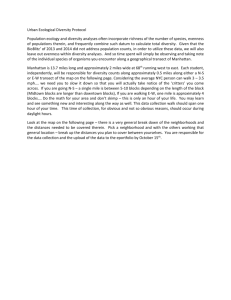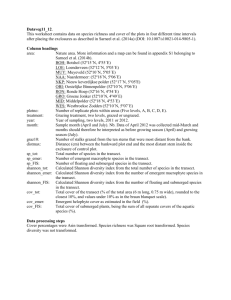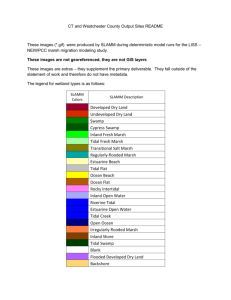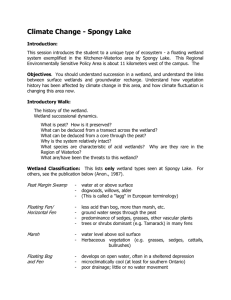DOC - Wetlands Regional Monitoring Program
advertisement
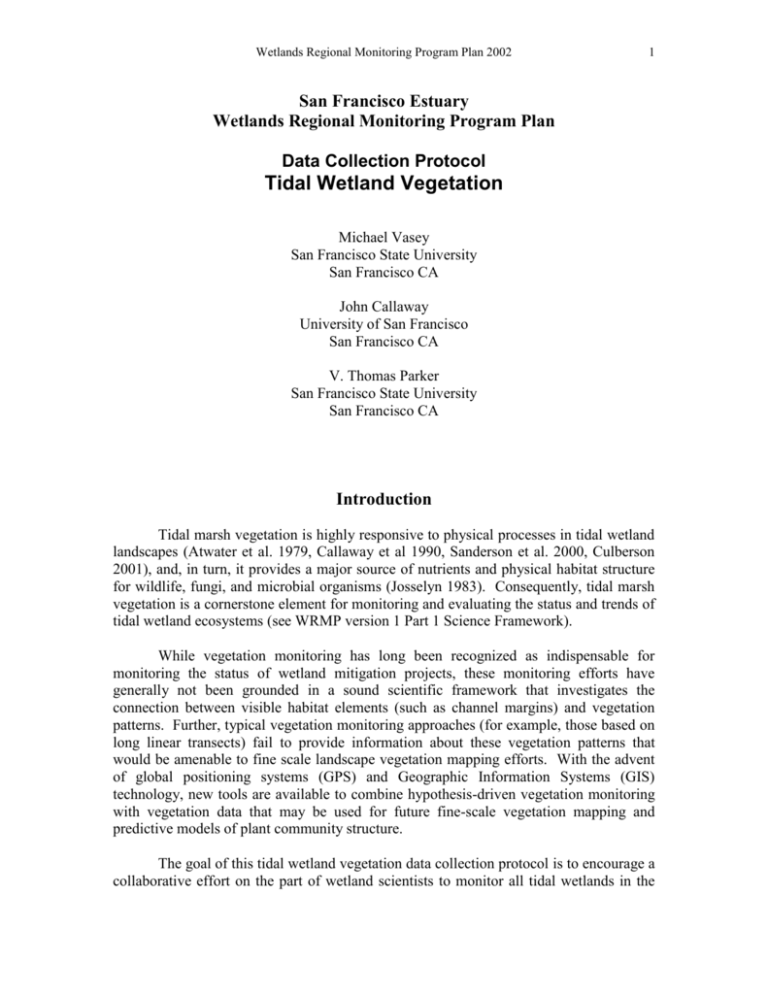
Wetlands Regional Monitoring Program Plan 2002 1 San Francisco Estuary Wetlands Regional Monitoring Program Plan Data Collection Protocol Tidal Wetland Vegetation Michael Vasey San Francisco State University San Francisco CA John Callaway University of San Francisco San Francisco CA V. Thomas Parker San Francisco State University San Francisco CA Introduction Tidal marsh vegetation is highly responsive to physical processes in tidal wetland landscapes (Atwater et al. 1979, Callaway et al 1990, Sanderson et al. 2000, Culberson 2001), and, in turn, it provides a major source of nutrients and physical habitat structure for wildlife, fungi, and microbial organisms (Josselyn 1983). Consequently, tidal marsh vegetation is a cornerstone element for monitoring and evaluating the status and trends of tidal wetland ecosystems (see WRMP version 1 Part 1 Science Framework). While vegetation monitoring has long been recognized as indispensable for monitoring the status of wetland mitigation projects, these monitoring efforts have generally not been grounded in a sound scientific framework that investigates the connection between visible habitat elements (such as channel margins) and vegetation patterns. Further, typical vegetation monitoring approaches (for example, those based on long linear transects) fail to provide information about these vegetation patterns that would be amenable to fine scale landscape vegetation mapping efforts. With the advent of global positioning systems (GPS) and Geographic Information Systems (GIS) technology, new tools are available to combine hypothesis-driven vegetation monitoring with vegetation data that may be used for future fine-scale vegetation mapping and predictive models of plant community structure. The goal of this tidal wetland vegetation data collection protocol is to encourage a collaborative effort on the part of wetland scientists to monitor all tidal wetlands in the 2 Wetlands Regional Monitoring Program Plan 2002 San Francisco Bay Estuary with a common conceptual approach and standard methods to generate tidal wetland vegetation data that (1) tracks vegetation change over time and (2) tests the hypothesis that habitat heterogeneity drives species diversity and vegetative complexity in tidal wetland landscapes (Callaway, Parker, and Vasey 2002). This approach will be used within the ambient monitoring and project monitoring components of the WRMP. We stratify tidal wetland landscapes into a number of habitat elements (e.g. channel margins, marsh plain, upland transition zone, etc.) that appear to provide distinct habitats for tidal wetland species (see WRMP version 1 Part 1 Science Framework). We then focus on randomly generating plant species cover data for these different habitat elements, as well as information about habitat structure for vertebrate and macro-invertebrate wildlife. Vegetative cover is generally a State Indicator that reflects the growing conditions for wetland vascular plants in tidal wetland ecosystems. It refers to the percent of a specified ground unit covered by each plant species located in a defined area. The Vegetative Cover Indicator provides insight into the number of species in a tidal wetland and the approximate abundance of each species in the wetland. It is particularly valuable for characterizing the distribution of common species that make up the bulk of the biomass in a tidal wetland and less valuable for identifying rare species. Vegetative cover can also be a Pressure Indicator for wildlife habitat, and for native tidal wetland plants if it reveals dominance by non-native invasive species. Personnel Volunteers who can identify wetland vascular plant species should be able to conduct this sampling if provided with appropriate orientation and supervision. Sampling Approach This protocol is designed to evaluate three important plant community parameters in tidal marshes: 1) plant species diversity, 2) community physical structure, and 3) the invasion of non-native species. A stratified-random sampling approach is used to characterize the plant community for these three parameters along major gradients of environmental factors that are expected to affect community structure, including its overall heterogeneity. The sampling takes place along these gradients within self-evident drainage basins within the sampling sites. The underlying assumptions of this approach are that species diversity and structural heterogeneity are sensitive to environmental stress, and that wetland managers seek to monitor stress levels. Sampling should therefore occur along gradients of factors that control or correlate to community heterogeneity. In tidal marshes, the key factors of interest within a marsh, such as tidal hydroperiod, environmental moisture, aqueous salinity, susceptibility to invasion by NIS plants, and edaphic chemical factors vary with intertidal elevation and distance from tidal source (see version 1 WRMP Part 1 Science Wetlands Regional Monitoring Program Plan 2002 3 Framework and Appendix B). This protocol therefore uses this spatial pattern of key factor variation as a sampling template. 4 Wetlands Regional Monitoring Program Plan 2002 Sample Universe This protocol is to be used to characterize the plant community of the primary strata of tidal marshes in the San Francisco Estuary. The ambient monitoring program will include wetland projects in the sample universe. Sample Sites, Strata, Habitat Elements Stations, Plots, and Sub-plots Site Starting Point Drainage Basin Mainstem Channel Station Transect Plot Subplot SAMPLING TERMS A wetland project or other patch of tidal marsh A randomly chosen point used to identify a drainage basin within a site. The area of tidal marsh that drains to a third-order or smaller channel network. The highest-order channel within a drainage basin. For this protocol, the mainstem channel is third-order or smaller. Location of a transect within a selected drainage basin. There are at least five Stations within each drainage basin. 15-m distance along which Plots are randomly located at a Station. There is one Transect per Station. A randomly chosen area 1 x 2-m in size within which data are collected. There are five plots at stations A, B and E, and three plots at stations C and D. 1 x 1-m subsection of Plot. There are two subplots within each Plot. Designations are given below for subplot numbering, and data are collected separately for each subplot. A sample site is a wetland project or other patch of tidal marsh habitat. The primary strata are the backshore (i.e., upland transition zone), marsh plains, channel margins, tidal pannes, and foreshore (i.e., bay-ward transition zones from the marsh plain to open tidal mud flats). Habitat elements are smaller scale significant variations in landform that are nested within these primary strata (See version 1 WRMP Part 1 Science Framework). Sample stations are locations of transects within the primary strata. Sample plots and sub-plots are places of individual measurements of vegetation cover or structure taken along the sample transects. All recognizable habitat elements within the primary strata will be included in the transects. The method of assigning order to a channel follows from Strahler 1957 (and see version 1 WRMP Part 1 Science Framework) will be as follows. The smallest channels with an unvegetated bank-face is termed first-order; the confluence of two or more firstorder channels forms the upstream beginning of a second-order channel; the confluence of two or more second-order channels forms a third-order channel, and so forth; a thirdorder network includes the entire length of one third-order channel plus all of its secondorder tributaries plus all of their first-order tributaries. A third-order drainage basin includes one third-order channel network plus the marsh plain that contributes surface runoff to any part of the network. The nature of the key strata and their habitat elements will vary from place to place and over time. The random selection of stations is necessary to monitor the response of the vegetation and to changes in tidal wetland landforms. Wetlands Regional Monitoring Program Plan 2002 5 To compare one site to another, this protocol will have to be replicated at least three times per site. Locating Stations and Transects It is preferable that a preliminary layout of the quantitative field sampling transects be done prior to field sampling, as this would likely speed up sampling in the field. This following process results in five sampling stations for each third-order or smaller randomly chosen tidal marsh drainage basin at a site. Sampling stations A and B represent channel-side and marsh plain conditions for the mid marsh, respectively. Stations C and D represent channel-side and marsh plain conditions for the low marsh at the foreshore. Station E represents conditions near the backshore. There is one transect at each Station. There are 5 Plots per transect at Stations A, B, and E, whereas there are 3 Plots per transect at Stations C and D. Large plots (1 x 2-m) are randomly located along each transect. Each plot is evaluated for total vegetative cover, cover by species, and plant height. 1. Generate a Staring Point: Once a site is selected, then a GIS is used to generate a 1-m to 10-m node grid for the site as a whole. The center points of the cells of the grid comprise the population of possible starting points for monitoring. The random selection of one of these points initiates spatial layout of stations and transects. Generate the Starting Point using a GIS and mark the Starting Point on an aerial photo-map of the site. 2. Define the Mainstem Channel: On the photo-map of the site, delineate the largest drainage basin that encompasses the Starting Point, up to a third-order basin. The highest-order channel of the basin is the mainstem channel. To delineate the boundaries of a drainage basin across the marsh plain and between adjacent channel networks, the rule will be to follow a line half way between neighboring channels of the adjacent networks. 3. Locate the Starting Point in the Field: Locate the Starting Point in the field using a GPS. Mark the Starting Point with a PVC stake. This location will be used to determine all sampling stations. 4. Station A: Draw a straight line parallel with the foreshore from the Starting Point to the nearest place along the mainstem channel of the drainage basin. This place is Station A. 5. Station B: Draw a line perpendicular to the channel bank from Station A to a place 20-m away on the marsh plain. This place is Station B. 6 Wetlands Regional Monitoring Program Plan 2002 6. Station C: Follow the channel downstream from Station A to a place near the opening of the channel at the foreshore. This is Station C. 7. Station D: Draw a line parallel to the foreshore from Station C to a place 20-m away from Station C. This place is Station D. 8. Station E: Draw a line from the Starting Point to the nearest place along the backshore. This place is Station E. 9. Permanent Transect: At any reference sites (i.e., semi-permanent sites along stressor gradients (see version 1 WRMP Part 1: Sampling Approach) or project sites, establish a fixed transect from Station E to the foreshore. Mark each end of this transect with a PVC stake and record its GPS coordinates. Figure 1. Schematic of Station Locations Upland E Backshore Marsh Plain Panne X A B D Foreshore C Mud Flat Bay Exceptions and Unusual Cases In some cases, the identification of marsh features may not be straightforward, or particular marshes may lack features that are used to locate sampling stations. Some possible exceptions in locating stations are outlined below: Wetlands Regional Monitoring Program Plan 2002 7 Wetlands where the channel is the main water body: Some wetlands may be a far distance from the bayshore of the Estuary (e.g., at a very long distance up a tributary river or stream, or upstream along a tidal slough with no fluvial input). In these cases, the major channel or river will serve as the main water body, and the vegetation border with the channel or river will be designated as the foreshore of the wetland. The next largest channel within the wetland should be used as the mainstem channel in locating the near-channel stations. Location of sampling stations will follow the procedure outlined above, using these designated features. Wetlands without channels: Some fringe wetlands may lack any large channels that could be used to identify near channel sites. Most Fringe Marshes have first-order channels that can be used, although these can be concealed by vegetation. If no channel can be located near the Starting Point on the photo-map or in the field, then both of the near channel stations (A and C) will be dropped, and sampling will be completed only at stations B, D, and E. The beginning of the transect at Station B will be located by walking parallel to the foreshore 20 m away from the Starting Point. The beginning of the transect for Station D will be located by walking directly towards the foreshore from the Staring Point, and the beginning of the transect for Station E will be located by walking in the opposite direction from the EMAP plot until reaching the backshore. Sampling at Each Station The quantitative data are collected at five plots that are randomly selected along each Transect at each Station, according to the following instructions. (1) For both the mid marsh stations (A and B), mark the ends of a transect that extends 15 m parallel to the main channel and toward the foreshore. For the transect that extends along the channel bank (A), areas that have slumped or areas found at lower elevation in the channel are not considered mid-marsh and are excluded from the transect for this sampling protocol. The transect for Station B, which parallels the mainstem channel but at a distance 20 m away from the channel bank, is further constrained to be at least 10 m from any other channel (see Figure 2 below). If the mid marsh transect that begins at Station B crosses a panne (i.e., a shallow depression of bare ground 10 m2 or larger with or without standing water), then Station B should be shifted far enough toward the foreshore or toward the backshore such that the transect from Station B does not intersect the panne. Five plots will be randomly selected along each transect (C and D; see Figure 3). (2) For each of the low marsh stations (C and D), the transect begins at the apparent upper boundary limit of the low marsh plant zone. The transect runs downhill from this boundary vegetation to the foreshore (i.e., the 8 Wetlands Regional Monitoring Program Plan 2002 edge of the adjacent tidal flat). Because the width of the low marsh zone varies among marshes, the length of these low marsh transects will also vary. Three plots will be randomly selected along each transect line for C and D (Figure 3). Only 3 plots are used for these stations because of the potentially narrow width of the low marsh zone. If transects within a station are less than 15 m, the first 3 random plots that are within the vegetated transect should be used. (3) For the backshore (Station E), the 15-m transect is anchored at the Station marker (see figure 1). The transect runs 15 m parallel to the backshore (not along the elevation gradient). The protocol for setting up quadrats is the same as for the mid-marsh sampling stations. (4) Special habitat elements. Some drainage basins will include tidal pannes that represent important habitats for plant species and assemblages that do not commonly occur within other strata or habitat elements. A tidal panne is defined as an area on the marsh plain of 10-m2 or larger with less than 25% perennial emergent vegetation. If pannes are present, randomly select one panne for detailed sampling. For the selected panne, randomly locate 5 plots (each plot is 1m x 2m) along the periphery of the panne. Collect data as outlined above for Sites A-E Minimum 10 m Figure 2: Schematic diagram of mid marsh stations and transects (bold lines) B 20 m A 15 m X Figure 3: Schematic diagram of low marsh stations and transects (bold lines) Wetlands Regional Monitoring Program Plan 2002 9 Data Collection The locations for the sample plots at each station are selected from the total number of 15 possible 1-m intervals on each transect (there may be fewer possible intervals at Stations C and D if the low marsh zone is les than 15-m wide; see discussion above). For transects A, B and E, five whole numbers between 0 and 14 are randomly selected, and the order of the numbers is recorded. Three random numbers are selected for both transects C and D. If a particular location is found to be unacceptable due to a disturbance or some other reason, an alternate random number should be used. Plots are situated along each transect using the random numbers (see Figure 4). Each of the randomly selected 1m x 2 m plots for each transect will be divided into two 1m x 1 m subplots (see Figure 5). Each subplot is designated as either subplot 1 or subplot 2, and data are recorded separately for each subplot. In the field, a 1 x 1 m frame can be used to sample vegetation, moving it from sample subplot 1 to subplot 2. Plots are always oriented in a particular direction. The long, 2-m side of each plot is oriented perpendicular to the transect line. Subplot 1 is situated adjacent to the channel for stations A, B, C and D, and adjacent to the upland for station E (see Figure 5). Figure 4. Five plots are located randomly along each transect using a random number table. Each plot is oriented such that the first subplot sampled is closest to the 10 Wetlands Regional Monitoring Program Plan 2002 channel. This illustration shows a hypothetical sampling routine for the midmarsh Stations (A and B). B A 2 1 2 1 2 1 2 1 2 1 2 1 20 m 2 1 2 1 2 1 2 1 Figure 5. The Plots used in sampling vegetation are 1m x 2m in size. These Plots are divided into 2 1m x 1m subplots. The subplot designated #1 is always oriented toward a channel (Stations A – D) or toward the foreshore (Station E). A portable 1m x 1m meter frame would work easiest for this sampling. 1m channel or foreshore side 1 2 1m 2m Within each subplot, data are collected in the following order. First the percent cover of all non-vegetated areas is estimated. Bare ground and litter-covered areas are estimated separately. Following this, the percent cover for each species is estimated Wetlands Regional Monitoring Program Plan 2002 11 separately. Visual estimates of cover are made using a modified Daubenmire cover class system using a 7-point scale, as indicated below. Because canopies may overlap, cover estimates may total more than 100%. The species and height of the tallest plant (to the nearest cm) is recorded for each subplot. Estimated cover categories >0-1% >1-5% >5-25% >25-50% >50-75% >75-95% >95-100% Cover class 1 2 3 4 5 6 7 Permanent Transect At any reference site or wetland project, a permanent transect will be established through the Starting Point from foreshore to backshore (see Figure 1) to assess changes in tidal wetland vegetation (and landforms) over time. Data on percent cover and maximum height per species will be collected every 1 meter for the first 30 meters from either end of the transect, every 1 meter within 10 meters of any channel or panne crossed by the transect line, and every 5 meters along the remaining transect lengths. Time of Sampling Sampling should take place at low tide to enable full access to sample sites. There is substantial flexibility in the timing of sampling during the tidal cycle, however, since plants don't move and access to the sample sites is the critical variable. Seasonality Yearly sampling should take place so that annual variation in vegetation can be tracked and correlated with other physical and wildlife patterns. The annual sampling should take place at approximately the same time each year, preferably in the summer when the maximum diversity of the tidal wetland vegetation is apparent. 12 Wetlands Regional Monitoring Program Plan 2002 Summary of Field Work The overall sampling protocol for each Station is summarized below. 1 2 3 4 5 6 7 8 9 Steps in Sampling at Each Station Determine lat/long for each sampling station with GPS. One 15-m transect is set up at each station using above protocols by anchoring each transect at the sampling station. Five plots are randomly located with a 15-m transect at each sampling station, except for low-marsh stations, C and D, which are likely to be less than 15 m long. At C and D, three plots are randomly located within the available length of transect. Sample plots that are “away from channels” must be at least 10 m from any channel. If plots are <10 m from any creek, throw these out and use random #’s to identify a new plot or readjust transect line. Each sample plot is 1m x 2 m in size, with the long dimension perpendicular to the transect line. Each 1m x 2 m plot is equally divided into two 1m x 1 m subplots, with the subplot nearest the creek or upland designated subplot 1. Data are collected separately for each 1m x 1m subplot. Run one permanent transect from foreshore to backshore, collecting data at varying intervals depending on distance from major strata, as described above. Data to be collected are: percent total vegetative cover percent litter as cover percent bare ground percent cover by species (for all species in each subplot) species and height of the tallest plant in each subplot A standard datasheet should be created for all quantitative data collected in the field. All plant species will have a designated two-letter code (e.g., Sv for Salicornia virginica), and these codes should be used when referring to any plant species. The data sheet should have, at a minimum, the following fields of information 1. 2. 3. 4. 5. 6. 7. 8. Sample site WRMP code and name Stratum code Station code and replicate number Transect identifier Sample date and time Plot replicate number and subplot number One field per each of the six data types (see step nine in summary table above) Comments Wetlands Regional Monitoring Program Plan 2002 13 Basic Field Equipment 100-m transect tape 1-m quadrat frames GPS unit Photo-map of site Random number table PVC markers Field guides to wetland flora Plant press for collecting reference specimens Field notebook Data sheets Expected Unit Cost Primary costs will be based upon field time for at least two investigators per sample locality. These unit costs will depend upon the salaries of the investigators and the time required for them to adequately sample the tidal wetland in question. Data Analysis Data will be analyzed per stratum. Each stratum will be analyzed for frequency of occurrence of each species, average cover per occurrence of each species, and maximum plant height per species. These data can then be used to assess dominant, common, and rare species in these different habitats. This will assist in the classification of plant alliances and associations for the various marsh sites that are investigated. It will also demonstrate the effect of stressors and habitat heterogeneity on biodiversity within and among marshes, strata, and habitat elements. Presentation of Results Histograms and other graphic presentations will demonstrate differences in species frequency, average cover, and average height for the different habitats that characterize tidal wetlands (i.e. channel margins, transition zones, marsh plains, pannes, etc.). Over time, restored wetland vegetation recovery patterns can be compared to reference conditions. 14 Wetlands Regional Monitoring Program Plan 2002 References Cited Atwater, B.F., S.G. Conrad, J.N. Dowden, D.W. Hedel, R.L. MacDonald, and W. Savage. 1979. History, landforms, and vegetation of the estuary’s tidal marshes. In: San Francisco Bay: the urbanized estuary, T.J. Conomos (ed.). Proceedings of the 58th annual meeting of the Pacific Division of the American Association for the Advancement of Science, San Francisco, CA. Callaway, R.M., S. Jones, W.R. Ferren Jr., and A Parikh. 1990. Ecology of a Mediterranean-climate estuarine wetland at Carpenteria, California: plant distributions and soil salinities in the upper marsh. Canadian Journal of Botany, 68:1990):1139-1146. Culberson, S.D. 2001. The interaction of physical and biological determinants producing vegetation zonation in tidal marshes of the San Francisco Bay Estuary, California, USA. Doctoral dissertation, Department of Ecology, University of California at Davis, Davis, CA Josselyn, M.N. 1983. The ecology of San Francisco Bay tidal marshes: a community profile. U.S. Fish and Wildlife Service Report FWS/OBS-83/23. Sanderson, E.W., S.L. Ustin and T.C. Foin. 2000. The influence of tidal channels on the distribution of salt marsh plant species in Petaluma Marsh, CA, USA. Plant Ecology, 146:29-41. Strahler, N.N. 1957. Quantitative analysis of watershed geomorphology. Trans. Amer. Geophys. Union 38:913–920.

